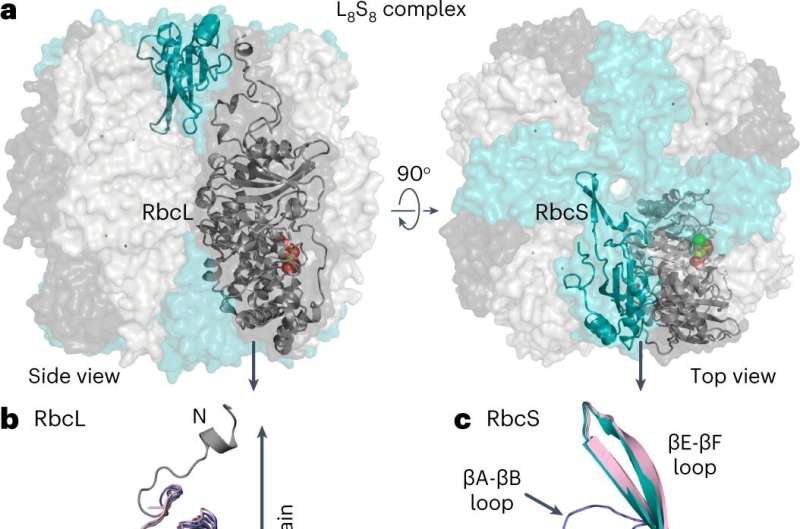This article has been reviewed according to Science X's editorial process and policies. Editors have highlighted the following attributes while ensuring the content's credibility:
fact-checked
peer-reviewed publication
trusted source
proofread
Red algae proteins grafted into tobacco double plant growth

A Cornell researcher and her colleagues have solved one key piece of the molecular puzzle needed to dramatically improve plant productivity and increase carbon sequestration: They have successfully transferred key regions of a highly efficient red algae into a tobacco plant, using bacteria as an intermediary.
The study was co-authored by Laura Gunn, assistant professor in the School of Integrative Plant Science Plant Biology Section in the College of Agriculture and Life Sciences, and featured on the cover of Nature Plants.
The study centers on Rubisco, the most abundant protein across every ecosystem on Earth. Rubisco performs the first step of photosynthesis by fixing carbon, and it appears in various forms in a wide array of organisms, including plants, red and green algae and bacteria. Rubisco is slow and struggles to differentiate between oxygen and carbon dioxide, a problem Gunn and several other Cornellians are working on. As a result, Rubisco often limits plant growth and crop yield.
One species of red algae, Griffithsia monilis (Gm), contains Rubisco that is 30% more efficient at fixing carbon than Rubisco in other organisms, including terrestrial crops. For at least 20 years, scientists have been interested in transplanting the highly efficient GmRubisco into plants such as rice, wheat, soybean and tobacco to increase their productivity; however, until now, no one has been able to successfully coax plants to express it.
This is because Rubisco requires multiple "chaperones" that are essential for the protein to fold, assemble and be active—there are seven such helpers in tobacco plants—and most of the chaperones in red algae are unknown, Gunn said.
In their study, Gunn and her co-authors were able to solve the 3D structure of GmRubisco and use this information to successfully graft a small number of regions from Rhodobacter sphaeroides (RsRubisco) into a bacterial Rubisco.
"RsRubisco is not very efficient, but it is very closely related to GmRubisco—they're like cousins—which means that unlike land-plant Rubisco, it accepts the grafted sequences," Gunn said. "RsRubisco also doesn't need any special chaperones for it to fold and assemble in land plants."
The change increased the carboxylation rate—the speed at which Rubisco starts the carbon fixation process—by 60%, increased carboxylation efficiency by 22% and improved RsRubisco's ability to distinguish between carbon dioxide and oxygen by 7%.
The authors then transplanted their bacterial mutant into tobacco, where it doubled photosynthesis and plant growth, compared to tobacco grown with unaltered RsRubisco. Tobacco is the easiest land plant in which to manipulate Rubisco and so serves as the test case for developing a more efficient Rubisco that can be transferred to more agronomically relevant species, Gunn said.
"We're not at the point where we're outperforming wild-type tobacco, but we're on the right trajectory," Gunn said. "We only need fairly modest improvements to Rubisco performance, because even a very small increase over a whole growing season can lead to massive changes in plant growth and yield, and the potential applications span many sectors: higher agricultural production; more efficient and affordable biofuel production; carbon sequestration approaches; and artificial energy possibilities."
More information: Yu Zhou et al, Grafting Rhodobacter sphaeroides with red algae Rubisco to accelerate catalysis and plant growth, Nature Plants (2023). DOI: 10.1038/s41477-023-01436-7
Journal information: Nature Plants
Provided by Cornell University




















